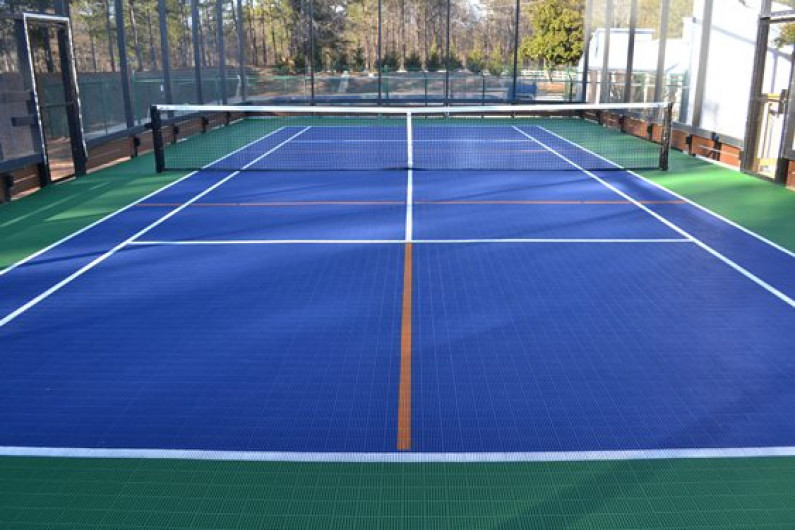Pickleball Court Construction-- Beginning Structure Your Perfect Court Today
Pickleball Court Construction-- Beginning Structure Your Perfect Court Today
Blog Article
Sustainable Practices in Pickleball Court Building You Ought To Know
As the appeal of pickleball continues to increase, so also does the need for sustainable methods in court construction. The effect of these techniques expands far beyond the court itself.
Picking Eco-Friendly Materials
Selecting green materials is a vital action in the building and construction of sustainable pickleball courts. The choice of lasting materials not just decreases ecological influence yet additionally improves the long life and efficiency of the court. Secret products include recycled rubber for the surface area, which offers outstanding durability and shock absorption while diverting waste from land fills.
In addition, using locally sourced materials reduces transport discharges and supports regional economic climates. Pickleball court construction. For instance, using indigenous woods for fencing and seats can supply a sustainable aesthetic while ensuring strength against the components.
Integrating permeable products for court structures can even more add to sustainability by enabling for all-natural water drainage and minimizing drainage. These options not just safeguard neighborhood ecosystems however likewise advertise healthier play atmospheres.
Efficient Drain Solutions
While the choice of environmentally friendly materials is vital, implementing effective water drainage solutions is equally crucial for preserving lasting pickleball courts. Proper drain not just protects the court surface area from water damage but likewise lessens disintegration and overflow, advertising ecological honesty.
Reliable water drainage systems can consist of permeable paving, which allows water to infiltrate the ground instead of pooling on the surface. This minimizes the chance of standing water, which can bring about mold and mildew and various other maintenance concerns. In addition, including tactically put drain channels and swales can guide excess water away from the court area, ensuring a completely dry playing surface area and stopping soil erosion.
Making use of native greenery in the landscape design around the courts can even more enhance water drainage by taking in excess water and decreasing drainage. These plants need less irrigation and advertise biodiversity, lining up with lasting methods.
Furthermore, it is important to frequently preserve the water drainage system to ensure its lasting effectiveness. This includes clearing up particles and monitoring for clogs. By focusing on effective water drainage options, pickleball court constructors can dramatically add to the sustainability and long life of the facility, eventually profiting both players and the environment.
Energy-Efficient Illumination Options
As the need for pickleball continues to grow, incorporating energy-efficient lighting options right into court style has actually ended up being significantly essential for sustainability. Standard lighting systems typically take in too much power, adding to higher operational costs and environmental effect. Consequently, adopting contemporary, energy-efficient technologies his comment is here is important for both new constructions and remodellings.
LED (Light Emitting Diode) lights sticks out as a leading choice because of its durability and energy financial savings (Pickleball court construction). Compared to standard illumination, LEDs use around 75% less energy and can last up to 25 times longer, significantly reducing maintenance expenses. Furthermore, the directional nature of LED lights reduces light air pollution, making sure that lighting is concentrated on the court as opposed to bordering locations.

Sustainable Surface Alternatives
Exploring sustainable surface area options for pickleball courts has actually gained traction among gamers and builders alike. The emphasis on environment-friendly products not just lines up with the expanding ecological understanding yet additionally boosts the performance and resilience of the courts.
This product offers excellent shock absorption, lowering the danger of injuries for players while promoting sustainability. These tiles are simple to set up and replace, and their adaptability allows for different court arrangements.
All-natural grass courts are likewise becoming a lasting option, advertising biodiversity and reducing the heat island impact. They need routine upkeep and water, which link might not straighten with all sustainability objectives.

Water Conservation Methods

Another reliable technique entails the installment of rainwater harvesting systems. These systems store and gather rain for use in maintaining court surfaces and landscape design. This approach not only preserves potable water yet also minimizes dependence on local resources.
In addition, employing drought-resistant landscape design around the courts is important. Native plants need much less water and are better adapted to regional environment problems, hence decreasing overall water usage. In addition, utilizing efficient irrigation systems, such as drip irrigation, guarantees that water is supplied straight to plant origins, reducing evaporation and waste.
Final Thought
Including lasting techniques in pickleball court construction significantly contributes to environmental preservation and resource efficiency. Using green products, applying reliable drainage services, and adopting energy-efficient lights alternatives can considerably decrease ecological influence. Checking out lasting surface alternatives and using water preservation methods enhance the total sustainability of these leisure centers. By prioritizing these techniques, the building of pickleball courts can line up with more comprehensive ecological goals while promoting longevity and functionality within areas.
As the appeal of pickleball proceeds to rise, so as well does the demand for sustainable methods in court building and construction.Choosing eco-friendly materials is an essential step in the construction of sustainable pickleball courts. By prioritizing energy-efficient illumination alternatives, pickleball court contractors can contribute to a much more sustainable future while meeting the needs of stakeholders and players alike.Integrating lasting surface area choices not just boosts the efficiency of pickleball courts yet additionally leads the way for executing efficient water preservation methods.Including sustainable practices in pickleball court construction significantly adds to ecological conservation and resource performance.
Report this page